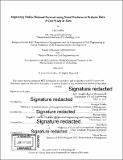| dc.contributor.advisor | Georgia Perakis and Patrick Jaillet. | en_US |
| dc.contributor.author | Fridley, Lila (Lila J.) | en_US |
| dc.contributor.other | Leaders for Global Operations Program. | en_US |
| dc.date.accessioned | 2018-09-17T15:52:17Z | |
| dc.date.available | 2018-09-17T15:52:17Z | |
| dc.date.copyright | 2018 | en_US |
| dc.date.issued | 2018 | en_US |
| dc.identifier.uri | http://hdl.handle.net/1721.1/117976 | |
| dc.description | Thesis: M.B.A., Massachusetts Institute of Technology, Sloan School of Management, in conjunction with the Leaders for Global Operations Program at MIT, 2018. | en_US |
| dc.description | Thesis: S.M., Massachusetts Institute of Technology, Department of Civil and Environmental Engineering, in conjunction with the Leaders for Global Operations Program at MIT, 2018. | en_US |
| dc.description | Cataloged from PDF version of thesis. | en_US |
| dc.description | Includes bibliographical references (page 77). | en_US |
| dc.description.abstract | The challenge of improving retail inventory customer service level while reducing costs is common across many retailers. This problem is typically addressed through efficient supply chain operations. This thesis discusses the development of new methodologies to predict e-commerce consumer demand for seasonal, short life-cycle articles. The new methodology incorporates novel data to predict demand of existing products through a bottom-up point forecast at the color and location level. It addresses the widely observed challenge of forecasting censored demand during a stock out. Zara introduces thousands of new items each season across over 2100 stores in 93 markets worldwide [1]. The Zara Distribution team is responsible for allocating inventory to each physical and e-commerce store. In line with Zara's quick to retail strategy, Distribution is flexible and responsive in forecasting store demand, with new styles arriving in stores twice per week [1]. The company is interested in improving the demand forecast by leveraging the novel e-commerce data that has become available since the launch of Zara.com in 2010 [2]. The results of this thesis demonstrate that the addition of new data to a linear regression model reduces prediction error by an average of 16% for e-commerce articles experiencing censored demand during a stock out, in comparison to traditional methods. Expanding the scope to all e-commerce articles, this thesis demonstrates that incorporating easily accessible web data yields an additional 2% error reduction on average for all articles on a color and location basis. Traditional methods to improve demand prediction have not before leveraged the expansive availability of e-commerce data, and this research presents a novel solution to the fashion forecasting challenge. This thesis project may additionally be used as a case-study for companies using subscriptions or an analogous tracking tool, as well as novel data features, in a user-friendly and implementable demand forecast model. | en_US |
| dc.description.statementofresponsibility | by Lila Fridley. | en_US |
| dc.format.extent | 77 pages | en_US |
| dc.language.iso | eng | en_US |
| dc.publisher | Massachusetts Institute of Technology | en_US |
| dc.rights | MIT theses are protected by copyright. They may be viewed, downloaded, or printed from this source but further reproduction or distribution in any format is prohibited without written permission. | en_US |
| dc.rights.uri | http://dspace.mit.edu/handle/1721.1/7582 | en_US |
| dc.subject | Sloan School of Management. | en_US |
| dc.subject | Civil and Environmental Engineering. | en_US |
| dc.subject | Leaders for Global Operations Program. | en_US |
| dc.title | Improving online demand forecast using novel features in website data : a case study at Zara | en_US |
| dc.type | Thesis | en_US |
| dc.description.degree | M.B.A. | en_US |
| dc.description.degree | S.M. | en_US |
| dc.contributor.department | Leaders for Global Operations Program at MIT | en_US |
| dc.contributor.department | Massachusetts Institute of Technology. Department of Civil and Environmental Engineering | |
| dc.contributor.department | Sloan School of Management | |
| dc.identifier.oclc | 1051238258 | en_US |
